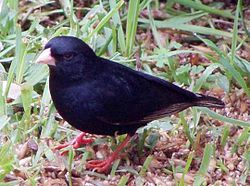- The name dusky indigobird can also refer to Vidua purpurascens .
| Dusky indigobird | |
|---|---|
 | |
| A male photographed in Pietermaritzburg, South Africa. | |
| Scientific classification | |
| Kingdom: | Animalia |
| Phylum: | Chordata |
| Class: | Aves |
| Order: | Passeriformes |
| Family: | Viduidae |
| Genus: | Vidua |
| Species: | V. funerea |
| Binomial name | |
| Vidua funerea (de Tarragon, 1847) | |

The dusky indigobird, variable indigobird, or black widowfinch (Vidua funerea) is a species of bird in the family Viduidae. It is found in Angola, Burundi, Cameroon, Republic of the Congo, Democratic Republic of the Congo, Eswatini, Guinea-Bissau, Malawi, Mozambique, Nigeria, Sierra Leone, South Africa, Tanzania, Zambia, and Zimbabwe. Its natural habitat is moist savanna.
